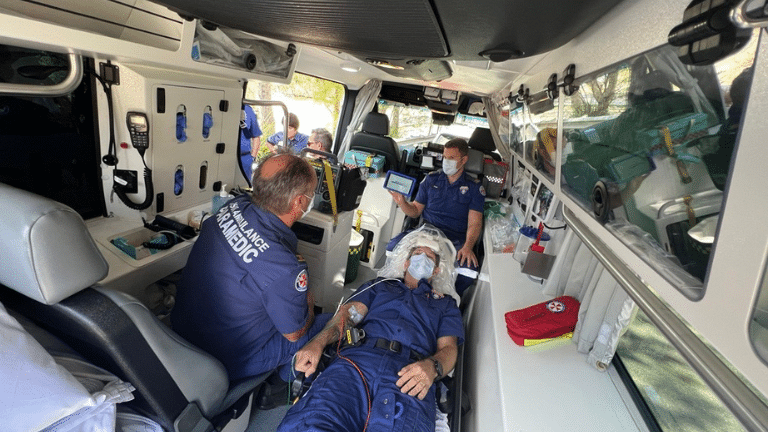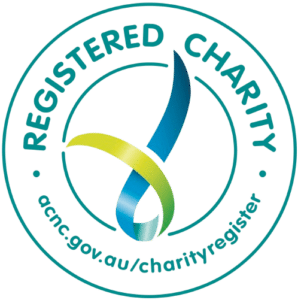
In Australia, someone has a stroke every 19 minutes.
Treatment of stroke has changed enormously over the last 25 years. Rapid identification, transport, imaging and treatment have led to more effective therapies thanks, in no small part, to HMRI research.

Paramedics undergoing Stroke Finder MD100 in-field training
Much of the work has been led by Professor Chris Levi (now Executive Director Research and Innovation HNELHD) and HMRI Heart and Stroke leader Professor Neil Spratt with colleagues Professor Mark Parsons, Dr Carols Garcia Esperon and Associate Professor Michael Pollack.
In 2017, HMRI commenced testing a revolutionary time-saving Stroke Finder helmet. The compact, portable device is fast-to-operate and able to perform multiple brain measurements in 60 seconds using microwave technology similar to that of mobile phones.
Just as defibrillators revolutionised cardiac care, these helmets are doing much the same for stroke. They are used in ambulances with tele-stroke capability, allowing paramedics to liaise with neurologists at hospital via audiovisual link, thanks to a research project by HMRI that commenced way back in 2015.
The stroke patient’s head is placed directly on the cushion-sized base and sequentially scanned by antenna pads emitting low-energy microwaves. Thesepulses “scatter” in brain matter, and bleeding patterns are then detected via an image-generating algorithm. The Stroke Finder is battery powered, wireless and operated via a tablet device.
The HMRI Sydney Foundation helped secure community funding for stage one of the Stroke Finder Helmet project, including a significant donation from the Schwartz Foundation, for the acute care pilot study.
Over the years, HMRI has provided seed funding and enabled clinical trials enabling a translation of research to help save lives beyond the stroke helmet.
“We’ve conceived, led and successfully completed several practice-changing clinical trials in stroke care, including the first trial internationally to identify the acute stroke,” Professor Levi said.
“This trial has led to international practice change and better outcomes for patients.
We conducted the first trial nationwide to establish pre-hospital stroke assessment methods including the ‘Brain to save’ protocols, and to change the model of care to divert patients to treatment capable hospitals.
“We have initiated the first trial nationally to use advanced CT imaging to guide telestroke assessments and clot-busting treatment delivery in regional hospitals, and we’ve also established Australia’s only regional comprehensive stroke centre with endovascular clot retrieval capability.”
Earlier this year, in a study of access to highly effective clot-retrieval therapy worldwide, Australia was found to have had the best coverage. This is due in a large part to the widespread use of advanced CT imaging pioneered by the HMRI team and its collaborators.
“Our teams are leading a large international clinical trial now to establish the effectiveness of a new clot-dissolving therapy for stroke.”
Dr Kirsten Coupland is part of the next generation of HMRI stroke researchers. Having completed her postdoctoral research at the Karolinska Institutet in Sweden, Dr Coupland joined HMRI in 2018 with a generous fellowship from the Dalara Foundation and has since been able to turn this philanthropic investment into a large NHMRC Ideas Grant.
Along with her team, Dr Coupland is now exploring how stroke affects the delicate composition and movement of cerebrospinal fluid and how that impacts patient outcomes.
HMRI would like to acknowledge the Traditional Custodians of the land on which we work and live, the Awabakal and Worimi peoples, and pay our respects to Elders past and present. We recognise and respect their cultural heritage and beliefs and their continued connection to their land.

Hunter Medical Research Institute
We’re taking healthy further.
Locked Bag 1000
New Lambton
NSW, Australia, 2305



This site is protected by reCAPTCHA and the Google Privacy Policy and Terms of Service apply.
Copyright © 2024 Hunter Medical Research Institute | ABN: 27 081 436 919
Site by Marlin Communications
